
But this is where the similarities end.įind out why SVN teams are migrating to Helix Core - and why your team should, too. And they do have many basic, similar commands. Helix Core and SVN can both handle large files better than Git. You can compare more commands at Mapping Subversion Terms and Commands to Perforce. Vincent Danen shows you an easier way of managing your dotfiles, those customized configuration files for various CLI programs that you use frequently.
#SUBVERSION CHEATSHEET UPDATE#
Obtain and update changes from the depot/repo to the client workspace. Provide information on changelists and changelists’ files. Open files in a client workspace to add them to the depot.Ĭompare files on the client workspace with revisions in the depot.ĭisplay information about the workspace files.ĭisplay information about the current client and server. SVN Commands Cheat Sheet Taskĭiscard changes made to open files and revert back to latest synced version. We've also included the Helix Core P4 command equivalent, if you're considering migrating to Helix Core. Here, we've compiled a quick reference guide to every SVN command you'll need to know. Need a handy SVN commands cheat sheet to reference? The svn help command provides a summary of available commands.ĭiscover the reasons why teams prefer Perforce Helix Core vs. The svn shelve command stores your changes without submitting them. The svn update command updates your working copy with changes from the repository. For example, you can use svn revert to undo svn add. The svn revert command reverts changes in your working copy, as well as property changes. The svn merge command combines two different versions into your working copy. The svn move command moves a file from one directory to another (or renames it). The svn log command shows log messages from the repository. The svn info command displays information about a local or remote item. The svn status command prints the status of working copy files and directories. The svn diff command reveals the differences between your working copy and the copy in the master SVN repository. The svn list command allows you to see a list of files in a repository without creating a working copy. The svn delete command will delete a file from your working copy of the repository. The svn add command will add a new file to the repository - but only after you've done a svn commit. The svn commit command sends your changes back to the SVN server. This command is sometimes shortened to svn co. The svn checkout command checks out a working copy from the repository. The svn import command commits an unversioned tree of files into a repository (and creates intermediate directories, if needed). The svn admincreate command creates a new, empty repository. Here are the basic SVN commands that every developer and admin should know.

SWITCH FROM SVN TO HELIX CORE Basic SVN Commands Because the commands are similar, it's easy to get started. That's because Helix Core delivers greater speed, scale, and security. Many teams have switched from SVN to Helix Core. Of course, this is just one of many useful SVN commands you should know.
#SUBVERSION CHEATSHEET HOW TO#
Related reading > How to Host SVN Repositories Simply use the svn list repository command, and you'll get a list of all repositories and their contents. Here we list out some of the most popular Subversion commands along with an SVN cheat sheet.įor example, using SVN commands can help you display a list of SVN repositories. It used to be called "git", but have since changed name.Using Subversion (SVN) for version control? With SVN commands, you can work in SVN more efficiently.

#SUBVERSION CHEATSHEET PORTABLE#
Git (Guitar/Instrument Tuner) is a defunct portable guitar tuner.gnuit (GNU Interactive Tools) is a set of file browsing and viewing tools (a text-based file manager).These should be uninstalled (or renamed) to use this git. Git is not to be confused with at least these three unrelated projects which also provide commands named git.

Older news Good starting places for developing Git would be October 12, 2016: Git User's Survey 2016 has been opened.October 21, 2016: Git User's Survey 2016 has been closed.Git Tools – Note: Have you written one? Add it here and announce it on the list!.Think of this site as a Wikipedia for Git. The more people who help work on this wiki the better this site will serve Git users. If you come across anything in this wiki or the Git homepage that needs to be fixed help yourself and fix it. The maintainers of the Git website would love patches for improving the website. The Git web site source is also managed using Git.

Make sure to visit the Git website () for current updates and information. This wiki is a community effort to provide an accurate source of information for all things related to Git.


 0 kommentar(er)
0 kommentar(er)
